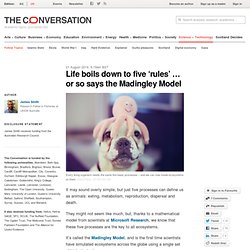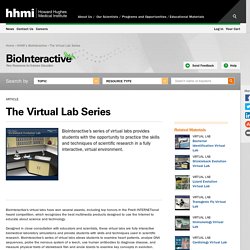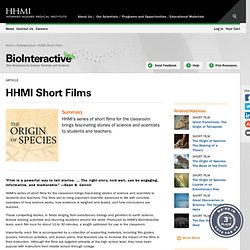

Digital Data Nuggets — DataClassroom. Introduction to Biology-HD.
Animals. Ecosystems and food webs. Animals- ocean, rocky shore, intertidal, fresh water. Microbiology and bacteria. Plants. Forensic Science. DNA. Biology simulators (some not iPad compatible) KS2 Bitesize Science - Living things. Welcome to Wild Eyes! Bio-technology. Gruseliges Video: MRT-Aufnahmen von Michael Volle bei „Lied an den Abendstern“ Resources: lesson plans, videos - Nature Works Everywhere. Biology. Darwin 2.0: Scientists shed new light on how species diverge. Birds that are related, such as Darwin's finches, but that vary in beak size and behavior specially evolved to their habitat are examples of a process called speciation.

It has long been thought that dramatic changes in a landscape like the formation of the Andes Mountain range or the Amazon River is the main driver that initiates species to diverge. However, a recent study shows that speciation occurred much later than these dramatic geographical changes. Researchers from LSU's Museum of Natural Science have found that time and a species' ability to move play greater parts in the process of speciation. This research was published today in the print edition of Nature. Brumfield and his colleagues examined the genealogy of 27 species of birds in the most bio-diverse region in the world, the Neotropics, which extends from southern Mexico through Central America to southern Brazil and includes the Amazon rainforest.
Life boils down to five 'rules' ... or so says the Madingley Model. It may sound overly simple, but just five processes can define us as animals: eating, metabolism, reproduction, dispersal and death.

They might not seem like much, but, thanks to a mathematical model from scientists at Microsoft Research, we know that these five processes are the key to all ecosystems. It’s called the Madingley Model, and is the first time scientists have simulated ecosystems across the globe using a single set of biological rules. When these rules are combined with your body mass at birth and your body mass at maturity, they are enough to define your role in an ecosystem.
In fact, they are enough to define any organism’s role (for plants, substitute “eating” with “photosynthesis”). The Madingley Model is a global ecosystem model (GEM). The first iteration of the Madingley Model was made available this year, and it works basically like this: Sounds good, but why bother? Click to enlarge Its most impressive feature may be the model itself. Complexity from a general view. Joan Wiffen (1922–2009) Changing scientific ideas Each specialised field of science has key ideas and ways of doing things.

Over time, these ideas and techniques can be revised or replaced in the light of new research. Most changes to key science ideas are only accepted gradually, tested through research by many people. Advances in science and technology All scientists build their research and theories on the knowledge of earlier scientists, and their work will inform other scientists in the future. Biography This part of the timeline outlines just a few events in the personal life of the featured person, some of which influenced their work as a scientist. Ancient Gondwana. Worm Watch Lab. The Virtual Lab Series. BioInteractive’s virtual labs have won several awards, including top honors in the Pirelli INTERNETional Award competition, which recognizes the best multimedia products designed to use the Internet to educate about science and technology.

Designed in close consultation with educators and scientists, these virtual labs are fully interactive biomedical laboratory simulations and provide students with skills and techniques used in scientific research. BioInteractive’s series of virtual labs allows students to examine heart patients, analyze DNA sequences, probe the nervous system of a leech, use human antibodies to diagnose disease, and measure physical traits of stickleback fish and anole lizards to examine key concepts in evolution.
Each lab provides an interactive environment in which students perform experiments and collect their data, and answer questions to assess their understanding. The labs can be accessed by clicking the icons on the right-hand side of the page. Cram.com: Create and Share Online Flashcards. Short Films. “Film is a powerful way to tell stories. … The right story, told well, can be engaging, informative, and memorable.”

—Sean B. Carroll HHMI’s series of short films for the classroom brings fascinating stories of science and scientists to students and teachers. The films aim to bring important scientific advances to life with concrete examples of how science works, how evidence is weighed and tested, and how conclusions are reached. Body & Nature.